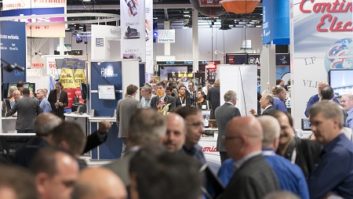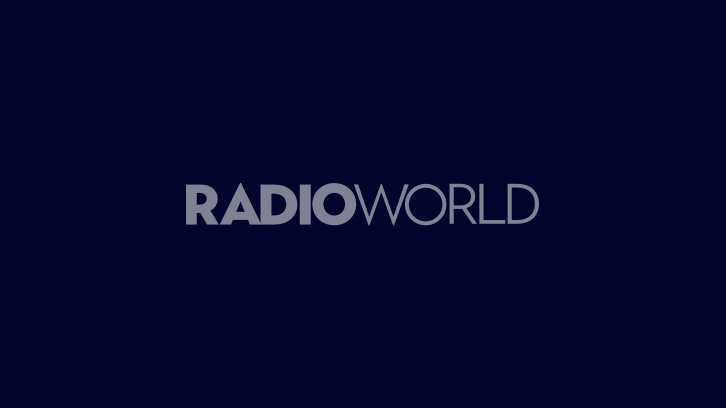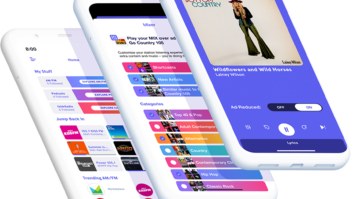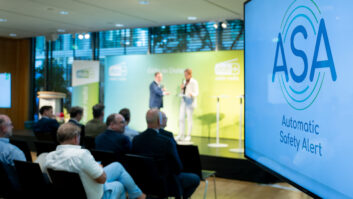A wrapup of news about HD Radio from the recent NAB Show. Some information was reported earlier in a different format.

All major companies selling cars in the United States offer HD Radio technology in some form, according to iBiquity Digital. Six were featured at the spring convention. Photo by Jim Peck
MAJOR AUTOMAKERS FEATURE HD RADIO
All major car manufacturers selling into the U.S. now offer HD Radio technology in one or more models, according to iBiquity Digital Corp.
In late April, Nissan said its first model to offer HD Radio will be the 2015 Murano, expected to arrive at dealerships in late 2014. HD Radio is part of an upgraded audio option.
The latest additions mean that by the end of this year, HD Radio will be available, as standard or as an option, from 35 manufacturers for a total of 185 models.
Approximately 90 of those models feature HD Radio receivers as standard equipment. Five automakers also use HD Radio technology to deliver traffic and data information to vehicles.
The technology developer says there are 16.5 million HD Radio-equipped vehicles on the road; one third of new vehicles sold in the U.S. came equipped with HD Radio in 2013. The company projects the number will reach 40 percent this year.
Why is most new receiver activity taking place in vehicles? Because that’s where most radio listening occurs and where stations derive the majority of ad revenue, according to experts like BIA/Kelsey, the Radio Advertising Bureau and Nielsen.
In fact, the table radio is going away and being replaced by a set of speakers connected via Bluetooth in an iPod dock, according to consumer electronics experts; clock radios are being replaced by tablets and cellphones and portable music devices are being replaced by smartphones.
“Consumers aren’t buying table radios. They’re carrying devices,” iBiquity Senior Director of Broadcast Business Development Jeff Detweiler told attendees of a Broadcast Engineering Conference session.
Some 2,200 U.S. radio stations are broadcasting with HD Radio technology, most of them on the FM dial. These stations account for 78 percent of domestic listening, resulting in an estimated 3.8 billion hours of annual HD Radio listening, according to BIA.
Based on a recent BIA report on top station revenues, 94 of the top 100 billing radio stations are broadcasting with HD Radio technology, according to the research company and iBiquity.
The majority of stations broadcasting in HD Radio are in major markets. Broadcasters in other cities have cited the cost of equipment conversion and iBiquity licensing as barriers to conversion.
Radio World asked iBiquity President/CEO Bob Struble what his message would be to stations that have yet to convert.
“It’s time,” he replied, citing HD Radio’s growing presence in the OEM world. “If you’ve been on the fence, it’s a good time to get off the fence,” because there are ways to monetize HD Radio, and digital stations will have a competitive advantage over analog stations, especially as automobile media systems evolve further.
“The connected car is real. It’s here, and HD Radio provides broadcasters an important and fundamental way to compete.” HD Radio audio and receiver displays are on par with those offered by services like Pandora, Spotify and others, Struble said in an interview.
Some critics, in addition to citing conversion costs, have questioned iBiquity’s receiver penetration figures and said that though HD Radio may now be included in more dashboard systems, consumers may not realize it’s there.
OEMs OFFER HD RADIO IN MEXICO, CANADA
More HD Radio receivers are becoming available in Canada and Mexico, as automakers and receiver manufacturers begin to standardize the technology across North America. That’s according to iBiquity Digital, which says 13 of the 35 automakers that sell HD Radio-equipped vehicles in the United States also offer them in Canada and Mexico.
Ford, Toyota, GMC, Chevrolet, Buick, Jeep, Dodge, Mazda, Mercedes-Benz, Infiniti, Lincoln, Mitsubishi and Ram now have vehicles offering HD Radio at dealerships throughout North America.
The Mexican government approved HD Radio as the digital standard for AM and FM in June 2011.
Mexico City has 13 FM HD Radio stations; they air 24 HD2 and HD3 channels. There are 25 more stations broadcasting with the technology in other areas of the country. About 30 percent of the Mexican population has access to an HD Radio broadcast; iBiquity says more broadcasters plan to adopt the format.
The tech developer has opened an office in Mexico City to promote the rollout, and added personnel in Mexico to support broadcasters, car dealers, brands and retailers.
Canada is evaluating the digital radio technology. Several of its border cities have access to HD Radio broadcasts from the U.S. Struble said the company’s automotive and receiver partners “welcome the advances in Canada and have expressed strong support for a unified North American broadcast standard behind HD Radio technology.”
The company says broadcasters and consumers will benefit from economies of scale associated with the rollout in Canada and Mexico, and that owners in those countries will benefit from being able to implement the more advanced version of the system now available.

To station owners who haven’t yet converted to HD Radio, iBiquity President/CEO Bob Struble says: “It’s time.” Photo by Jim Peck
HD Radio aftermarket automotive receivers are available in Canada from Alpine, Clarion, JVC, Kenwood, Pioneer and Sony, as well as home AVR receivers from Denon, Onkyo and Yamaha. The retail channel will continue to expand as additional stations convert to digital broadcasts, iBiquity says.
We recently reported Canadian Multicultural Radio launched HD Radio broadcasts on 101.3 MHz in Toronto. CMR is using HD Radio multicasts to address the needs of a diverse community, with an HD2 in the Tamil language, HD3 in both Hindi and Urdu, and HD4 in Punjabi.
ALL-DIGITAL AM TESTS CONTINUE
Results of all-digital AM testing continue to look positive, and NAB Labs is charting a path to asking the FCC for authorization eventually, should broadcasters want to do that.
So said NAB Senior Director of Advanced Engineering David Layer at a Broadcast Engineering Conference session.
The most recent testing involved Greater Media’s WBT(AM), Charlotte, N.C.; Cumulus-owned KTUC(AM), Tuscon, Ariz.; and WD2XXM, an iBiquity test station in Frederick, Md. All of these already were airing hybrid digital signals.
NAB Labs is using consumer receivers, primarily OEM radios in Ford vehicles, to characterize the all-digital coverage. Personnel have also tested in BMWs using Volvo receivers.
The fact that testing is being conducted with receivers available in rental cars is in contrast to the reference receivers used some 11 years ago in iBiquity’s initial AM all-digital testing.
Cumulus Senior Vice President of Engineering and IT Gary Kline told attendees that the all-digital audio sounded “far better than I expected” and that he walked away from the tests “feeling pretty good about running all-digital HD on AM.”
Greater Media Vice President of Radio Engineering Milford Smith told RW the all-digital AM HD Radio signal on Class A, 50 kW clear channel WBT “was very robust,” more so than the hybrid signal. This was the second round of testing on WBT, to eliminate anomalies found in round one last year.
NAB Labs has now conducted drive tests on five AMs and hopes to test on another four facilities in 2014. More owners are offering stations for testing now, according to NAB.
The NAB Radio Technology Committee has identified the types of facilities it wants for further testing. Categories include a station with a non-directional antenna; a station with a directional antenna; an expanded band station; a Class A in the lower band; a Class D; and a Class C with a complex antenna array.
Consulting firm Cavell and Mertz is developing a lab test facility that will be located at NAB Labs; the aim is to formulate repeatable tests that back up the drive data.
Smith told Radio World the NRSC has discussed the possibility of eventually evaluating all-digital AM, similar to the testing that preceded FCC authorization of IBOC.
All AM HD Radio receivers in the field today can receive all-digital signals.
What has NAB Labs learned from testing so far? Layer said that coverage of the AM all-digital signal exceeds that of the hybrid signal. This was shown experimentally in 2002 and confirmed at WBT in 2014 using production hardware.
The all-digital signal is more robust than the hybrid AM signal, and coverage is dependent on co- and adjacent-channel interference.
FCC BUREAU CHIEF “ENJOYING THE DIGITAL RADIO”
It’s always interesting to learn about the media and technology habits of those who regulate media. Now we learn that FCC Media Bureau Chief Bill Lake is experiencing HD Radio firsthand.
He told attendees at an FCC panel that “as a listener,” he’s “enjoying the digital radio in his new car,” and that he believes “it’s key for the auto industry to add digital radios to their product line.” He didn’t identify the car make or model.
“Anything the radio industry can do to promote [digital radio] is good for the industry,” he said. After an attendee complained he couldn’t find a home receiver in stores, Lake replied that he’d also found a new digital home radio at Best Buy.
An NAB official confirmed to RW that Lake was referring to HD Radio.






